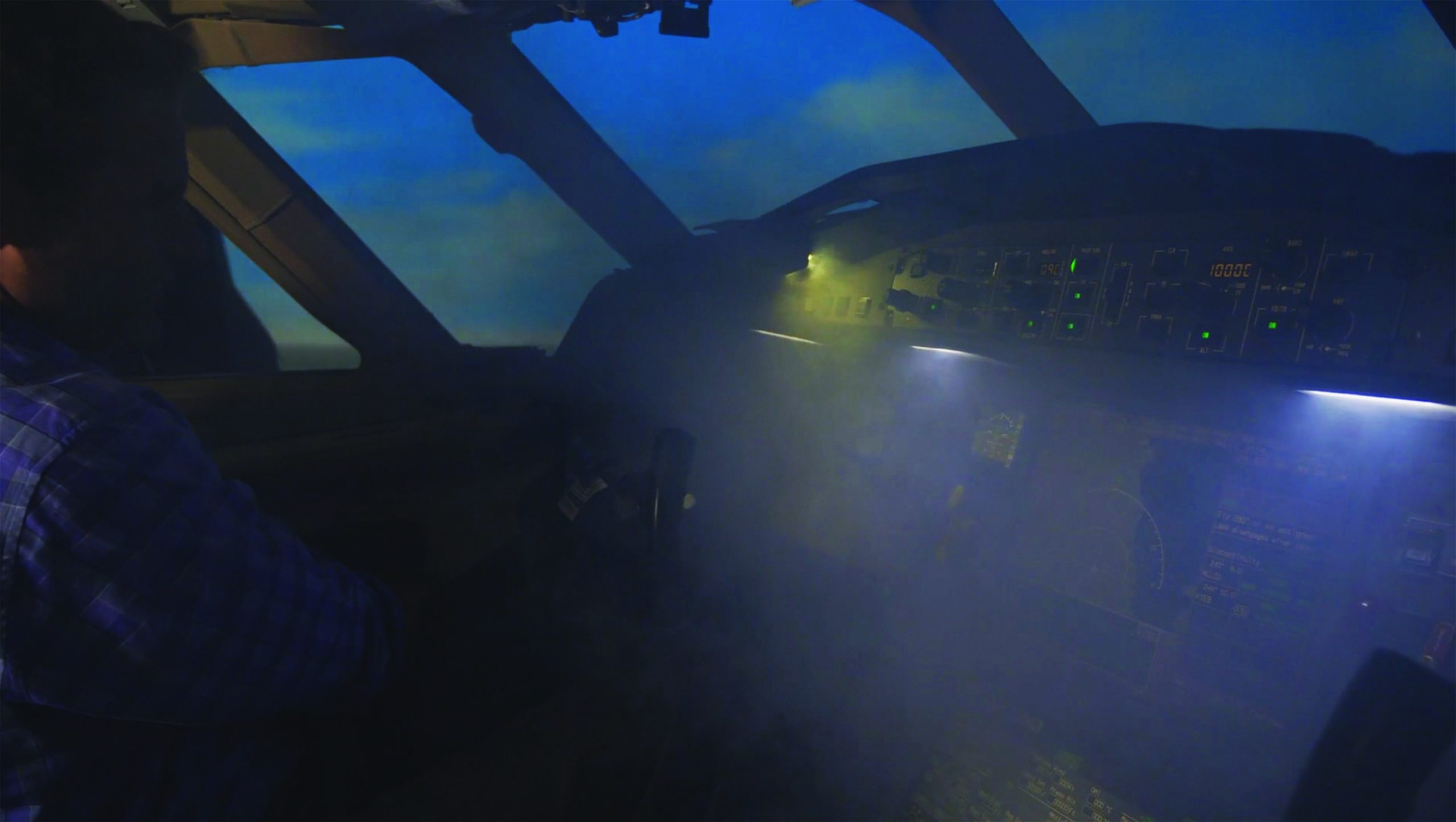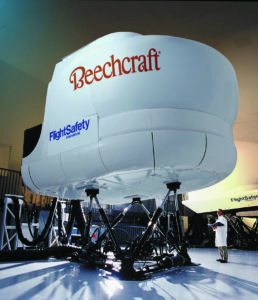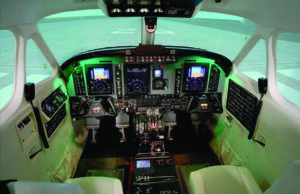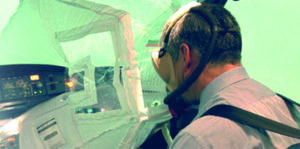Beech av denne typen er ikke så veldig sivile akkurat. Antakelig utstyrt for ISR. (Red.)
Cockpit Smoke
An event involving a partial engine failure and thick smoke in the cockpit has a favorable outcome, thanks to excellent crew coordination and training.
Editor’s note: Following is a first-person account of an in-flight emergency, namely smoke in the cockpit, aboard a civilian Beechcraft King Air 300 over Afghanistan in February 2019. This account preserves the operation’s security, its exact location and identities of the crewmembers. It’s the sole opinion of the author, who was the flight’s pilot-in-command, and in no way reflects the policies or opinions of any other entity. Its sole purpose is to provide pilots and aircrew with insight as to what may be encountered in a similar situation and to provide a real-world example in order to better prepare them for this type of emergency.
This was an otherwise-routine, night VFR mission, and a proficiency flight for the SIC, who was serving as pilot at the controls (PAC). At 2345 local time and after approximately three hours on station at 24,000 feet MSL about 20 miles east of the airfield, the PIC, in the right seat and the pilot not flying (PNF), saw a two-to-three-foot-high vertical wall of thick gray smoke enter the cockpit between his right shoulder and the right cockpit window. The entire cockpit was engulfed in this smoke after approximately five to eight seconds. Neither pilot could see any visible reference outside or inside the cockpit. None of the flight instruments or navigation devices were visible.
The crewman in the rear of the cabin was standing at the time, adjusting some equipment, and noticed the smoke exiting the cockpit and beginning to fill the cabin. Upon seeing the smoke, he returned to his seat and donned his oxygen breathing system.
Reacting
The first actions of the pilots were to don oxygen masks and locate their smoke goggles. After a few seconds, the PIC/PNF noticed the smoke was not burning his eyes and announced this to the crew. The PIC elected to not use the smoke goggles. After approximately 10-15 seconds, with the smoke continuing to obstruct all visibility, the PIC/PNF felt for and found the left and right bleed air valves and moved them to the “Environmental Off” position. After 15 more seconds, the smoke cleared enough that the cockpit instrument lights and lower console were partially visible.
The PIC/PNF directed the SIC to enter a course in the flight management system (FMS) direct to their home airfield’s initial approach fix (IAF). As the SIC accomplished this task, the aircraft began a shallow right turn toward the fix approximately 10 miles away. Concurrently, the PIC contacted approach control and declared an emergency, stating there was smoke and fumes in the cockpit along with the number of souls and fuel aboard the aircraft. He informed the controller the aircraft was descending from FL240 to 12,500 feet, and would proceed directly to the IAF for the ILS approach.
Getting Down
After flying toward the IAF for approximately 60-90 seconds, the PIC acquired the airport visually and instructed the SIC/PNF that he, the PIC, had the controls and would fly the aircraft to landing. The PIC disconnected the autopilot and hand-flew the aircraft into a descending, approximately 3000-fpm, standard-rate right turn toward the airport. The PIC put the props full forward and lowered flaps to their approach setting to assist with the descent.
Immediately following the control change, the SIC/PNF announced, “We’re losing the right engine; I see high oil temperature, low oil pressure, and we have a low oil pressure master caution light.” The PIC advanced the throttles slightly and observed the left engine responding normally and the right engine torque gauge fluctuating between 10 and 20 percent. He then returned the throttles to flight idle to continue the descent. Simultaneously the SIC/PNF selected “TERRAIN” view in the center console display and both pilots visually confirmed a “green” display (no immediate danger of impacting terrain).
The PIC instructed the cabin-seated crewman to slew the aircraft’s camera system to look forward of the aircraft and notify him of any high terrain that the aircraft might impact. The PIC then contacted approach control and informed them he would continue his descent to a right base and land the aircraft visually. As the aircraft descended through 12,000 feet, the PIC asked the SIC/PNF the distance to the runway. The SIC/PNF stated, “Five miles, and I have the ridgeline in sight; you’re clear.”
The PIC continued the descent, electing at this time to not shut down the right engine, instructed the SIC to lower the landing gear, and that the landing would be made using approach flaps only instead of full flaps. The SIC announced the aircraft’s weight and recommended approach speed.
The cabin crewman stated there was no dangerous terrain between the aircraft and the runway, visually confirmed the landing gear was down, and advised he would stow and secure the camera. The SIC/PNF verified the landing checklist was complete. The PIC informed the crew and control tower he would utilize the first half of the runway and exit the runway at the midfield taxiway.
Upon an uneventful landing, the PIC announced he would not utilize reverse thrust to slow the aircraft and was able to exit the runway at midfield. The PIC informed the tower controller he would clear the runway and taxiway, proceed to the company’s ramp area and shut down at that location. Upon entering the ramp, the crew performed an emergency engine shutdown and exited the aircraft.
Post-flight inspection by the maintenance department led them to believe an oil seal had failed, allowing oil into the engine’s compressor section. The resulting smoke then entered the cabin through the aircraft’s environmental system. Examination revealed the engine had no oil remaining. An engine inspection had not yet been completed at this writing.
Observations
The mission had been ongoing for 3.0 hours, approximately 1.5 hours remained and the crew was completely surprised by the emergency. I (PIC) was in a high state of shock for approximately 10 seconds as smoke engulfed the cockpit. My breathing rate rapidly increased, became shallow and a rapid heart rate was felt. I would describe this moment as moderate panic, disbelief and the most scared I have ever been in my life, followed quickly by a sense of, “Calm down, take control and handle the situation.”
After taking the controls, I disconnected the autopilot because the aircraft was not responding to my inputs fast enough and I had the airport clearly in sight. An approach-flap landing was safest because I did not want the extra drag associated with a full-flap landing in the event the right engine did completely fail.
It turns out that both of us in the front seats separately and to ourselves considered shutting down the right engine but we individually came to the same conclusion: Given the high state of activity, adrenaline rush, difficulty in clearly communicating and proximity to landing, the danger of securing the wrong engine was not worth the risk. Securing the right engine would have provided a minimal advantage only if done perfectly.
I had fairly extensively memorized the local terrain, including elevation of the highest peaks, and knew the approach. This proved invaluable during a rapid, non-standard descent with limited internal and external visibility. Adding to the comfort level was that both pilots were well-versed in the aircraft’s terrain awareness equipment. The aircraft’s location in relation to dangerous high terrain was never in question.
We were lucky that repositioning the bleed air valves stopped further smoke from entering the cockpit. Plus, the event occurred in close proximity to a safe place to land (10-15 minutes). The failing engine did not fail completely, so the potential for shutting down the incorrect engine due to the elevated workload was never a factor.
My crew and I acted as a team. Due to extensive training, coordination, near-perfect crew resource management (CRM) and aeronautical decision-making (ADM), this was an event and not a disaster. I emphasize this not to impress the reader but to emphasize that, had many factors beyond our control in our training and crew pairing not aligned perfectly, the outcome may have been different.
Lessons
That different types of smoke and their sources (e.g., electrical versus oil) require different procedures was driven home to me after this event. The published procedures clearly but very subtly reflect this difference. In the future, I will be better prepared for different types of smoke and fumes. Also, blind cockpit drills in my training greatly assisted me in quickly finding the bleed air switches and prevented more smoke from being pumped into the cockpit.
I did not follow the written procedure in securing the bleed air valves fully and one at a time. I did not feel I needed to nor had the time to isolate each valve. After securing both environmental valves, cabin pressurization was minimally affected, if at all.
In hindsight, I could have partially dumped the cabin pressure to evacuate the smoke. I didn’t because I incorrectly thought the cabin would entirely and immediately lose pressurization. I have since been informed the cabin dump switch can be momentarily activated to release partial pressure. I could have also raised the cabin altitude slowly, further decreasing the smoke in the aircraft.
The keys to our success were training, knowledge of the environment and remembering to fly the airplane.
The Beech/Raytheon/Textron Super King Air 300
The aircraft involved in this event is a variant of the most popular general aviation turboprop ever built, the Beech King Air. The Super King Air 300 is available in two versions, offering either a maximum takeoff weight of 14,000 lbs. or 12,500 lbs., in a lightweight model.
At A Glance:
Powerplants/shp: P&WC PT6A-60/1050
Max. Range: 1480 NM
Max. Cruise Speed: 320 KTAS
Max. Altitude: 35,000 feet
Training, Practice and Crew Communication
The company instructors who initially trained me all discussed, allowed and encouraged me to practice for smoke and fumes in the cockpit, including practice putting on the oxygen mask and goggles. This significantly countered the initial panic I felt in this event as I had “already been here.” I wish I had practiced more because during the actual emergency, locating, donning and properly wearing the mask and headset was difficult. The mask fits well, but partially obstructs vision and makes a lot of noise when breathing, so communications can be very difficult.
The smoke goggles were not needed because this was an oil-based smoke and there was very little eye irritation. Had this been an electrical fire, the goggles provided would have been nearly useless. They do not seal, so smoke would be trapped inside the goggles, and they are not stored in a convenient location if required immediately. I will be using a pair of sealable swim goggles and have them readily available in the future. I’ll also frequently practice using the oxygen mask, goggles and headset to the point of complete proficiency.
Having very standardized procedures for everything was critical during this emergency. Crew verbal and non-verbal communication was highly degraded. Having standardized navigation and cockpit processes was critical. The formal checklists and informal reminder checklists we have led us to set up our displays and navigation systems predictably. On several occasions, the crew acted predictably and without verbal instruction. Things as simple as the crewman using the camera to scan forward for terrain, check the landing gear was down and the pilots thinking alike probably prevented this incident from turning catastrophic.
EVAS Recommendation
Since this event, I have been made aware of a system called EVAS (Emergency Vision Assurance System), produced by VisionSafe for a variety of aircraft, mostly Part 25 transports and business jets. I was able to visit the company, try the system and understand how it is used and operates. I’m convinced having EVAS would have minimized our reliance on luck, as discussed in this article.
Had any one of our “luck factors” not been present, the situation could have ended in the complete loss of a multi-million-dollar asset, the loss of support the asset provides to protect the lives of our military, a victory for our enemies and the loss of three American lives.
Based on these factors, I recommended a cost-benefit analysis be conducted on the purchase and use of the EVAS system for every crewmember involved in these operations. Or we can continue to rely on luck.
Crew Status
It helped that this crew was flying over familiar terrain, and may all your emergencies happen 20 miles from your home plate’s initial approach fix, with gobs of altitude. But there’s no doubt a well-trained, experienced and proficient crew was a key factor in the favorable outcome of this event. For example:
- All crewmembers were highly experienced for this mission and intimately familiar with the operating area.
- All crewmembers had previously flown together at various times but never all at the same time. Having highly standardized procedures was key.
- The PIC had flown regularly in the previous five weeks and is an instructor pilot.
- This was the SIC’s first flight after returning from a 60-day break, and this flight was his evaluation following his time off.
- The cabin crewmember had flown regularly in the previous two weeks.
– Jeb Burnside, Editor-in-chief, Aviation Safety magazine
Hugh V. Tillman is a former U.S. Marine Corps Aviator. He’s currently sharing his passion for safe flying as a flight instructor, based in Hawaii.









Ingen kommentarer:
Legg inn en kommentar
Merk: Bare medlemmer av denne bloggen kan legge inn en kommentar.